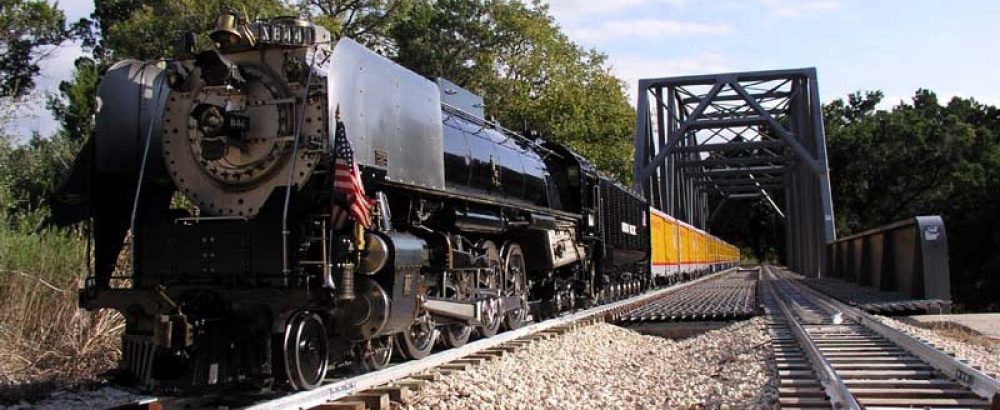I have run on many tracks across the United States, England, and New Zealand. I have seen only a handful of railroads that supported full-time bi-directional running with automatic signals.
… and fewer still that:
- Guarantee that only one train can enter a controlled area at a given time (ABS and APB signals can not do this – more later)
- Reliably detected trains under any weather conditions.
- Maximize the number of trains that can be handled by preventing deadlocks when possible.
At the minimum, by adding passing sidings and installing a properly designed signal system, even the smallest railroad can add realism and, in most cases, double the effective run-length of the railroad without adding a significant amount of track.
My goal was to design a signal system that would support full-time bi-directional running using fully automatic signals (i.e.: the engineer does not have to activate buttons, etc. to control the signals). I try to replicate full-size practice when possible but I make changes where I feel the design better suits ride-on practice and engineers.
Problems with Engineer Operated Buttons To Control Signals
I enjoy running my UP Northern (4-8-4) bi-directional because meeting and passing other trains adds another level of interest and realism.
In years past there was a track I would go to every year for a large meet. Most of the time the railroad would run in uni-directional mode but, on Saturday night they would setup the railroad to run bi-directional using engineer-operated buttons next to the track – one at the start of a block to ‘capture’ it, and one at the end of the block to ‘release’ it … simple, right?
After dinner everyone would fire up and head out of the yard. In fairly short order there would be calls on the radio asking why a given signal was red forever and the railroad would come to a stop. It would be discovered that someone had captured a block when they shouldn’t have, forgotten to clear it upon leaving, etc. The issue would be cleared but, invariably it would happen over and over which resulted in people getting frustrated and parking their trains.
The issue was not that the system didn’t work (in some cases buttons failed, but not often*), it was a case of the system not being used correctly by visiting engineers who were unfamiliar with the system or were just plain inattentive or forgetful (we are all getting older …).
* Button/switch failure can be addressed by using industrial weatherproof limit switches but these do not eliminate the improper use issue and the price is such that, for about the same cost you can install fully automatic signals.
I decided that there had to be a better way …
(note: the railroad mentioned above is now in the process of installing the MiniRail Solutions automatic signal system)
You can implement automatic signals with relays but there are issues with this approach – see: Problems With Traditional Approaches To Automatic Signals
The common “Occupied/Unoccupied” approaches to automatic bi-directional signaling use a single “head” signal at each entry to a block (many can not handle more than two entries to a single block). Initially all signals for the block are Clear (Green). When a train enters the block both(all) signals drop to Stop (Red). These systems suffer from one critical flaw: They do not guarantee that no more than one train is ever given permission to enter a block at any given time (remember, all signals were initially green). Systems using traditional relay-based “occupied/not occupied” signaling can not prevent two trains from entering a given block. Consider the following:
Two trains approach opposite ends of a block at nearly the same time. They both observe that their signal is Clear (Green). They both observe that their signal turns to Stop (Red) when they pass their signal – result: A “cornfield meet” within the block. The problem is that both engineers saw the signal turn red when they entered the block but, in fact, one of the signals turned red just prior to the locomotive entering the block because the block was captured by the other locomotive – result: both engineers think that they captured the block and thus they proceed – to a cornfield meet.
Full-scale railroads handle this issue with APB signals by ensuring that there is at least one set of intermediate signals within the bi-directional track. See: Why ABS or APB Signals Are Not Sufficient.
My Approach
My main interest is applying modern micro-controllers to ride-on scale railroads. Modern micro-controllers can enable much greater utilization of any railroad by managing traffic flow in a full-time bi-directional environment or by simply adding more realism and reliability for smaller railroads.
Most issues that people run into with solid-state approaches to automatic signals are due to nearby lightning strikes. All of my products are offered with lightning protection but this equipment is installed outdoors and a very close/direct lightning strike will damage things – but these same circumstances will damage relay systems as well. For a more in-depth discussion of lightning issues, see: Living With Lightning, and The Viability of Solid-State Components for Signal Systems.
There are many approaches to ride-on scale railroad signal systems. The MiniRail Solutions signal system can enhance any railroad, simple to complex, uni-directional or bi-directional but the decision of what type of signal system to use is based on many factors. What works best for one railroad might not be the best fit for another.
Please browse the pages, articles, and documentation on this site and feel free to contact me with any questions you may have.
I am happy to discuss signalling issues with you even if you are not interested in a full-blown system.

